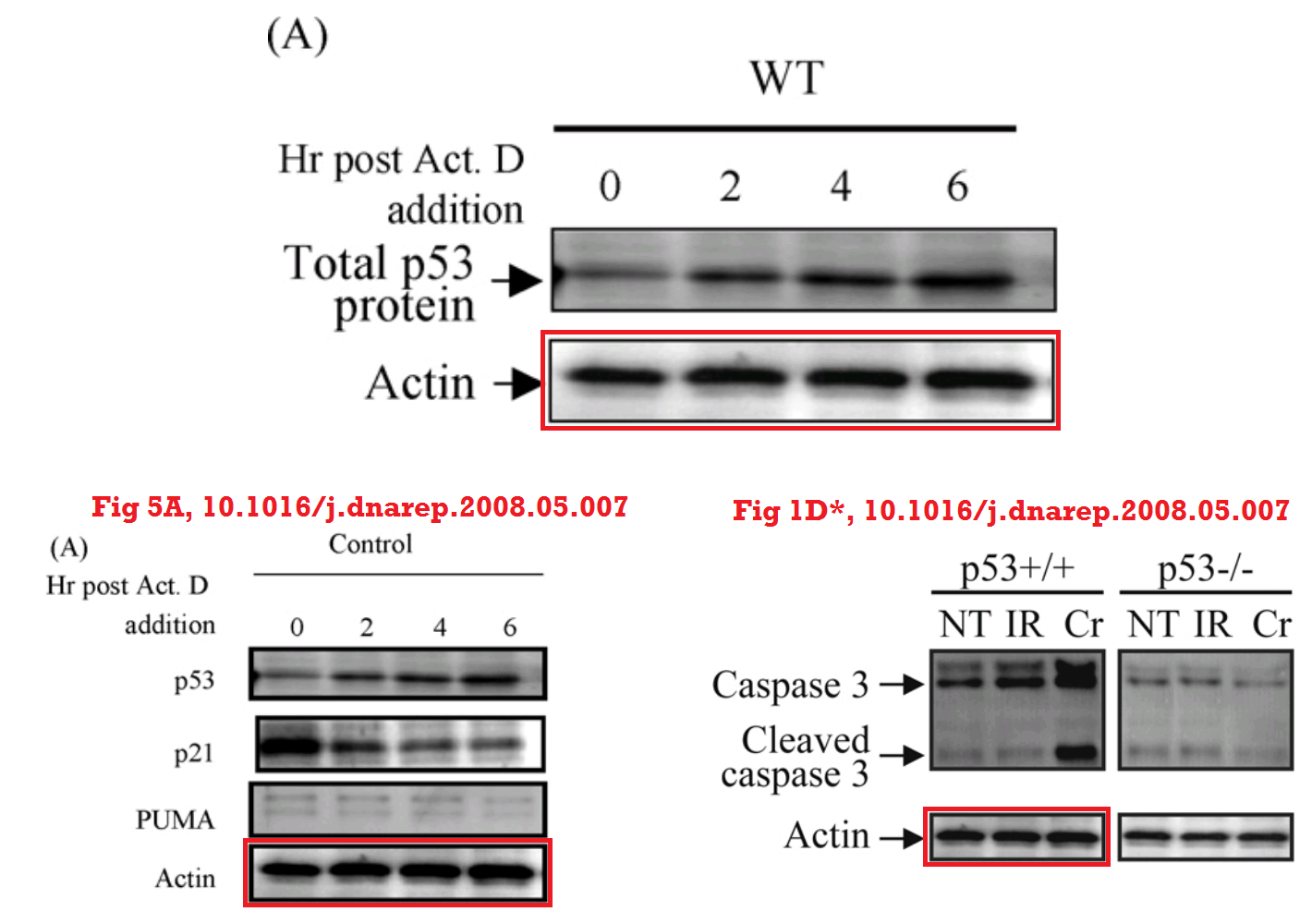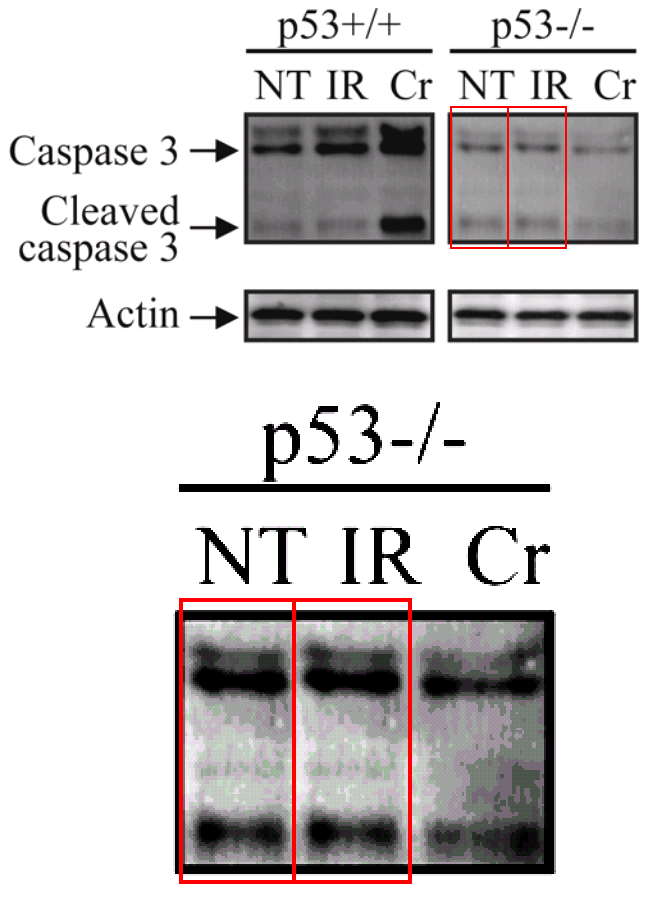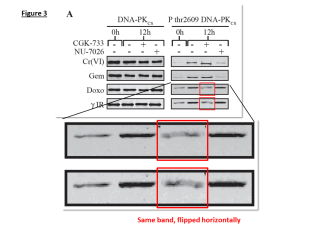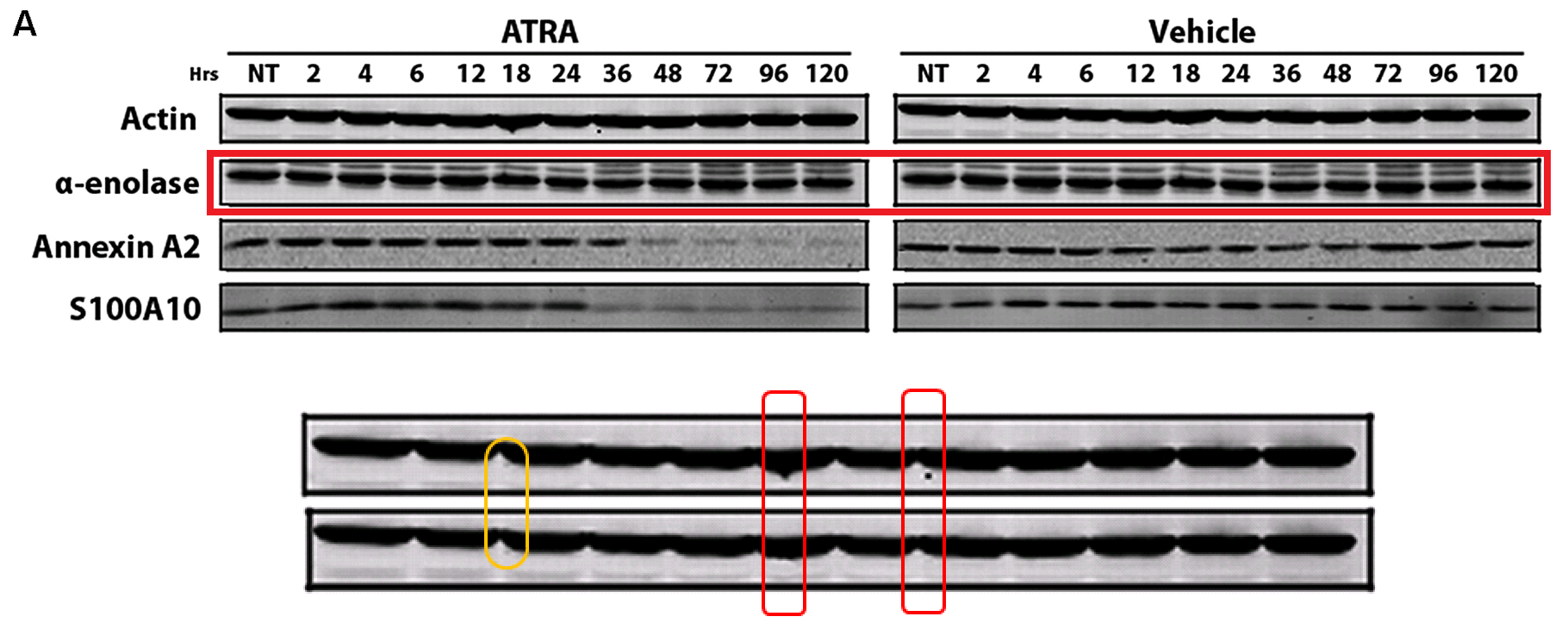For those of you who started to miss Smut Clyde, he is back, with a whole travelling circus of fake western blots in tow. The central character here is the cancer researcher Richard Hill, a tough and rather physically intimidating English lad who used to sport a hairstyle popular among certain kind of football fans, and who looks at you from each photo as if he is about to headbutt you in the teeth. The photos don’t reveal what kind of boots Hill is wearing, but even from what we see it’s no wonder his western blots jumped through hoops backwards to do whatever Hill barked at them. Basically, it is good for Smut to be far, far away from Hill’s temper.
Dr Hill is namely tenured fellow at the University of Portsmouth in UK, where he took over a drug discovery unit on behalf of the retired professor Geoff Pilkington, and in this new role Hill continues to produce rigged science, which his university proudly pushes in press releases.
Update 25.10.2019: Hill was reported by two independent sources to have resigned from Portsmouth, as misconduct investigation began. See more below.

Hill was recruited to Portsmouth from the Universidade do Algarve in Faro, Portugal, he still collaborates from his past colleague there, Patricia Madureira, who is also incidentally his wife. The family business might now urgently need a scapegoat to blame, any takers?

Just weeks ago, on 5 August 2019, University of Portsmouth issued this press release celebrating Hill’s allegedly successful test of a cancer drug which they now announce to bring into a clinical trial on humans. The trials were also announced by Hill in an interview with a brain cancer charity which funds his lab. Hill was asked “What’s been the biggest surprise to you as a result of your research?”, to which he mumbled something about “highly interactive patient networks, support groups“. Thanks to Smut Clyde, Hill will be getting his surprise now.
This is namely the blot-flipping science of Mihaljuk et al 2019 which the patients are to be treated with:

Before the stint in Portugal, Hill used to be a postdoc at the Dalhousie University in Canada, where his retired ex-boss Patrick Lee now fingers Hill in an email to me as the sole responsible for data irregularities in their common papers, and acknowledges to have reported the suspected research misconduct to the university’s authorities. Lee also wrote:
“I was informed of the issues raised in PubPeer several years ago and was both shocked and saddened by the evidence presented. I immediately contacted Dr. Hill and the journals involved, and felt that the fairest way to deal with this matter would be for Dr. Hill himself to provide his own defense/rebutal to these allegations, and let the journals decide on their acceptability. While some issues have since been resolved, others are still in the process of being sorted out. I was not aware of similar issues raised regarding his publications in Dr. Pilkington’s laboratory, until now. “
So we have two retired professors, and a bunch of soft journal editors. Mere pushover for Dr Hill. I will now hide behind the bushes also, and let Smut Clyde face the man now.
Dr Hill’s hilarious legerdemain, by Smut Clyde

Watch closely now, as I transform a Western blot of p21 protein blobs into a band of “Total p53”, and an Actin loading control into a different one, using only contrast enhancement and a horizontal flip! You’ll notice that at no time through the proceedings do my hands leave my wrists [Milligan 1972]. It is an unparalleled feat of prestidigitation, performed to great acclamation before the crowned heads of Europe, such as you will see nowhere else… unless you read decade-old cell biology journals, and particularly Hill et al (2008a) [1] and Hill et al (2008b) [2].
In total that Actin control band makes four appearances. It also illustrated Hill et al (2008c) [3], in a similar role. Then in 2013 the authors of [2] provided a Corrigendum to correct the excessive re-use of illustrations from [3], amending Figures 1, 4, 5 and 7 (which might not reach the threshold of what the RetractionWatch observers call a “mega-correction“, but is a “macro-correction” at the very least). The Actin band vanished from Figure 5A, but rose again in its fourth incarnation (truncated to three lanes and repurposed for a different set of conditions) within the new Fig 1D*.

Further displays of legerdemain await readers who care to examine the appropriate PubPeer threads… for instance, other concerns with the new Fig 1D*. I wrote this (as is the custom of my people) by strip-mining those threads and others, and by cherry-picking the low-hanging fruit in an unfortunate pile-up of metallurgical and horticultural metaphors, so it is not meant to be exhaustive. Admire, in passing, the similarities of three streaks of mRNA expression, from the ‘0-hour’ conditions of different experiments (after adjusting for lightness):
Some of the critiques of [2] involved Figures reused from [3] with different lanes or labels in the reuse, so they were preempted by the 2013 Corrigendum. Others were not.
So far we have looked at a remarkable trilogy from the Department of Microbiology and Immunology at Dalhousie University, Halifax (a city best-known for exploding, a century ago). By the time of Hill et al (2013) [4] the group had acquired second affiliations with the University of Algarve (on the south coast of Portugal), while following the same policy: repurposing protein bands from Western blots into new ones as evidence that experiments had indeed occurred. Often the bands were flipped vertically or horizontally, which had the unintended side-effect of making the re-use less apparent.

Now in electrophoresis commentary, one school of thought holds that loading controls are no big deal, because researchers can be confident that their cell-lysate preparations reliably contain the same total amount of protein. So it is fine if they do not bother with controls in an experiment, and fake them later while preparing a Figure (to grudgingly assuage the Third Reviewer’s unreasonable demands), cutting out the necessary number of lanes from any old source, like strips of wallpaper. Like this:

It is harder to be complaisant when the conjuring trick of inversion turns one protein into another.
 Skipping a few years brings us to Hill et al (2017) [5]. By now Professor Lee had retired and the Dalhousie team had dispersed… or at any rate, relocated to University of Algarve. The proteinaceous transformations continued, reaching new heights of exuberance. The authors display an open-minded acceptance or even permissiveness towards their slices of gel: if one chooses to identify as AKT or β-actin rather than FOX03a why stand in its way?
Skipping a few years brings us to Hill et al (2017) [5]. By now Professor Lee had retired and the Dalhousie team had dispersed… or at any rate, relocated to University of Algarve. The proteinaceous transformations continued, reaching new heights of exuberance. The authors display an open-minded acceptance or even permissiveness towards their slices of gel: if one chooses to identify as AKT or β-actin rather than FOX03a why stand in its way?

TRIB2, I’d like to introduce you to pSER253-FOX03a… but I see you’ve already met.

The number of pairs of duplicated bands in Figure 2(c) (the doubling variously concealed by rescaling, darkening or horizontal flips) exhausts the number of colors available to show their kinship.

Figure 4(e) is intimidating in its scale but at least one dup triplication emerges from its murky depths.

The innovation in [5] is the provision of Supplementary Information files containing raw data – the original Western Blot gels (full-size and un-retouched) from which the in-text illustrations came as cleaned-up excerpts. Alas, these raw-data files are lower-resolution than those image files in the text. More to the point, they mirror the in-text duplications.
The charitable impulse when one finds an image repeated in a paper to illustrate different results is to think “Someone accidentally chose the wrong panel while assembling a complex Figure”, but this “carelessness” interpretation is not an option when ‘raw gels’ have been created by flipping and selectively cropping an original, and changing the labels on the lanes.


By 2019, regular first author Richard Hill had found a permanent post as Senior Research Fellow at Portsmouth University, so I think of these last two papers as the Portsmouth Diptych: Mihajluk et al (2019) [6] and Howarth et al (2019) [7]. They are linked by an Actin loading band, serving to equalise overall protein concentration across different sets of conditions in independent studies of two wholly-different proteins. Is there nothing that a horizontal flip can’t accomplish?

 Dr Hill’s photographs on the Portsmouth University website are chosen to convey a sense of concentration and brooding intensity. I am left wondering whether one of the Midwich Cuckoos survived the explosive denouement of that novel and went on to a successful career in cell-biology research.
Dr Hill’s photographs on the Portsmouth University website are chosen to convey a sense of concentration and brooding intensity. I am left wondering whether one of the Midwich Cuckoos survived the explosive denouement of that novel and went on to a successful career in cell-biology research.
 [6] and [7] are subdued in comparison with [5] but one still finds blotty duplicates working double-time to illustrate different experiments. Again, the duplications are paralleled by the fabrication of flipped, selectively-cropped “original unretouched gels” in the Supplementary Data files, so they are unlikely to be accidental. [7] is of special interest because there the fabrication was in the service of a patent application for a new class of anti-cancer drugs, filed by “Opal Oncology Ltd.” (a company founded by co-author Morley).
[6] and [7] are subdued in comparison with [5] but one still finds blotty duplicates working double-time to illustrate different experiments. Again, the duplications are paralleled by the fabrication of flipped, selectively-cropped “original unretouched gels” in the Supplementary Data files, so they are unlikely to be accidental. [7] is of special interest because there the fabrication was in the service of a patent application for a new class of anti-cancer drugs, filed by “Opal Oncology Ltd.” (a company founded by co-author Morley).



[Thx Melipona Capixaba]

To compensate for that lack of exuberance, I violated chronological sequence and left the best until last. Prepare yourself for Hill et al (2011) [8]. In fact we saw its Figure 1A already, as the lower half of a comparison with [4], but the majority of the linkages are internal. They are completely over-the-top, with splicing within bands on top of the insouciant recycling.
‘Condylocarpon Amazonicum’ commended the Supplementary Data file to the readers’ attention. It is a Blot Bacchanalia.
Protein bands cavort and caper, tumbling and swapping faces like figures in the marginalia of medieval manuscripts, or like the unleashed familiars in ‘The Downfall of Hermogenes‘.
How this Western Walpurgisnacht was ever accepted for publication is anyone’s guess. Perhaps Dr Hill used his Cuckoo mind-control powers on the Oncotarget editors and peer-reviewers.
[8] could serve as an educational resource for would-be contributors to PubPeer, to train them gradually in spotting blot manipulations or repurposing, for the shenanigans are not well-concealed and there is nothing too challenging for the untrained eye. Proving in passing that whatever its detractors might say, Oncotarget can play a useful role in the scientific literature.
[1] Richard Hill, Michael D. Bodzak , Patrick W.K. Blough , Patrick W.K. Lee
p53 Binding to the p21 promoter is dependent on the nature of DNA damage.
Cell cycle (2008) doi: 10.4161/cc.7.16.6440 PubPeer here.
[2] Richard Hill , Andrew M. Leidal , Patricia A. Madureira , Laura D. Gillis , David M. Waisman , Arthur Chiu , Patrick W.K. Lee
Chromium-mediated apoptosis: involvement of DNA-dependent protein kinase (DNA-PK) and differential induction of p53 target genes.
DNA Repair (2008) doi: 10.1016/j.dnarep.2008.05.007 Pubpeer here.
[3] Richard Hill , Andrew M. Leidal , Patricia A. Madureira , Laura D. Gillis , Haley K. Cochrane , David. M. Waisman , Arthur Chiu , Patrick W.K. Lee
Hypersensitivity to chromium-induced DNA damage correlates with constitutive deregulation of upstream p53 kinases in p21−/− HCT116 colon cancer cells.
DNA Repair (2008) doi: 10.1016/j.dnarep.2007.10.001 PubPeer here.
[4] R Hill, M Rabb, P A Madureira, D Clements, S A Gujar, D M Waisman, C A Giacomantonio, P W K Lee
Gemcitabine-mediated tumour regression and p53-dependent gene expression: implications for colon and pancreatic cancer therapy.
Cell Death and Disease (2013) doi: 10.1038/cddis.2013.307 PubPeer here.
[5] Richard Hill, Patricia A. Madureira, Bibiana Ferreira, Inês Baptista, Susana Machado, Laura Colaço, Marta Dos Santos, Ningshu Liu, Ana Dopazo, Selma Ugurel, Angyal Adrienn, Endre Kiss-Toth, Murat Isbilen, Ali O. Gure, Wolfgang Link
TRIB2 confers resistance to anti-cancer therapy by activating the serine/threonine protein kinase AKT.
Nature Communications (2017) DOI:10.1038/ncomms14687 PubPeer here.
[6] K. Mihajluk , C. Simms , M. Reay , P.A. Madureira , A. Howarth , P. Murray , S. Nasser , C.A. Duckworth , D.M. Pritchard , G.J. Pilkington , R. Hill
IP1867B suppresses the insulin-like growth factor 1 receptor (IGF1R) ablating epidermal growth factor receptor inhibitor resistance in adult high grade gliomas.
Cancer Letters (2019) doi: 10.1016/j.canlet.2019.05.028 PubPeer here.
[7] Alison Howarth , Claire Simms , Nitesh Kerai , Olivia Allen , Karina Mihajluk , Patricia A. Madureira , Giannis Sokratous , Simon Cragg , Sang Y. Lee , Andy D. Morley , Ashkan Keyoumars , Paul A. Cox , Geoffrey J. Pilkington , Richard Hill
DIVERSet JAG Compounds Inhibit Topoisomerase II and Are Effective Against Adult and Pediatric High-Grade Gliomas.
Translational Oncology (2019) doi: 10.1016/j.tranon.2019.07.007 PubPeer here.
[8] Richard Hill, Patricia A. Madureira, David M Waisman, Patrick W.K. Lee
DNA-PKCS binding to p53 on the p21WAF1/CIP1 promoter blocks transcription resulting in cell death.
Oncotarget (2011) doi: 10.18632/oncotarget.378 PubPeer here.
Update 24.08.2019
On 23.08.2019, Geoff Pilkington finally replied, saying he has been away on vacation without internet access. He immediately announced an investigation. I was also informed that Adrian Parry, Executive Director of Corporate Governance at Portsmouth University, wrote in an email today:
“…we have instigated an investigation. The investigation will be taken forward in accordance with the University’s “Procedure for the Investigation of Allegations of Misconduct in Research”. A copy of this document can be found at: http://policies.docstore.port.ac.uk/policy-023.pdf?_ga=2.1109553.1837825534.1566309627-64763708.1535967744 “
Update 10.09.2019
A Screening Panel was assembled at University of Portsmouth to investigate the Hill case. The panel Chair Karen Ball, Head of School of Pharmacy and Biomedical Sciences, even invited “Ms Francis” to give evidence in person. I tried to alert Ball and the other two panel members, Jerome Swinny and Matt Guille, that this “Clare Francis” is a pseudonym, not the British novelist, just as this Karen Ball isn’t. To no avail.
Update 25.10.2019
Two independent sources confirmed to me that Hill has resigned from his position at Portsmouth University.
In other developments, Hill issued a corrigendum for Mihajluk et al Cancer Letters 2019, which goes like this:

“In the article above, we, the authors, discovered that a single microscopy panel was inadvertently placed in Figure 1f, using the SEBTA-023 panel twice instead of the SEBTA-003 representative image. We discovered that an actin western blot loading control data associated with Figure 3a was also incorrectly placed in Figure 5i. We retrieved the original actin western blot data linked to Figure 5i and corrected this error.
Neither correction alter the conclusions of the original paper; however, we sincerely apologize for any confusion that this may have caused.”
Thing is, the corrected Figure 5i does not match the raw data authors provided in same paper, as criticised on PubPeer:

It also appears Hill only pretended to have issued the Corrigendum in agreement with his coauthors. Geoff Pilkington, the penultimate author, informed me:
“I am not involved with any independent enquiry process although I have requested that such process should be carried with all haste as I think it is in the best interests of everyone that this matter is dealt with honestly and expediently.
Moreover, I have not communicated with Richard on this matter, nor have I seen him since my return from New Zealand.”
Update 28.10.2019
Maybe it was too early to pity Pilkington as a hapless and clueless victim of a dishonest successor. Turned out, Pilkington was not honest himself, on 25 October he told me a fib about not having known of the correction. Which lets one wonder how trustworthy all his other statements are.
Manfred Schwab, EiC of Cancer Letters and emeritus professor at DKFZ, Heidelberg, wrote to me today in regard to the disputed correction:
“thanks for pointing out to us the possible problems with this manuscript. It is our policy to contact the corresponding author for comment. After this, we will take the necssary actions. In cases of obvious scientific misconduct we have a zero-tolerance policy.
[…] Geoff Pilkington did send an email confirming that he approves of the changes on the 29th of August.”

Donate!
If you are interested to support my work, you can leave here a small tip of $5. Or several of small tips, just increase the amount as you like (2x=€10; 5x=€25). Your generous patronage of my journalism, however small it appears to you, will greatly help me with my legal costs.
€5.00
















“Hill was recruited to Portsmouth from the Universidade do Algarve in Faro, Portugal, he still collaborates from his past colleague there, Patricia Madureira.”
Patricia Madureira sans Richard Hill.
http://www.bloodjournal.org/content/117/15/4095?sso-checked=true
Regulation of S100A10 by the PML-RAR-α oncoprotein
Paul A. O’Connell, Patricia A. Madureira, Jason N. Berman, Robert S. Liwski and David M. Waisman
Blood 2011 117:4095-4105; doi: https://doi.org/10.1182/blood-2010-07-298851
https://pubpeer.com/publications/17E011389206C424054093E0CB6098
Figure 5A.
LikeLike
Fig 1A.

LikeLike
Just got a rejection from a journal and the main reason was lack of a full mechanistic explanation why our cancer drug works very efficient in PDX models. When you see all the junk science published in the very same journals, you get a bit frustrated. I really hope it will go down Hill!
LikeLike
Well, there is always the possibility that he move to Hollywood and he and Jason Stratham are the bad guys in the next Die Hard movie sequel. In America there is always a chance one can reinvent himself….
LikeLike
I do not like judge people based on their look. But on professional ground, these blots warrant retractions. Even less overwhelming irregularities can pull down a paper: https://www.ncbi.nlm.nih.gov/pmc/articles/PMC5133963/.
LikeLike
A good point. Leonid Schneider can vouch for the fact that my own personal appearance and choices of clothing are not designed to inspire anyone with confidence or trust,
LikeLiked by 1 person
C. Amazonicum continues to have fun with the Supplementary Figures from the 2011 Oncotarget paper, even if the result looks like an explosion in an arrow factory.
LikeLike
Crikey mate: Halifax (NS) is renowned for a great many other things, including nearby lighthouses, the Tattoo, and exceptional evolutionary microbiology. And anyway, rampant rebuilding has wiped out far more old buildings downtown than the explosion managed to. But yeah, egregious stuff abounding.
LikeLike
I needed the “explosion” theme for the narrative.
LikeLike
Richard Hill announces retraction of Oncotarget. 2011 Dec;2(12):1094-108 on Pubpeer
See: https://pubpeer.com/publications/8A3553A6E3588DA79EC450A57E1CE5#29
LikeLike
2019 retraction notice.
2019 retraction http://www.oncotarget.com/index.php?journal=oncotarget&page=article&op=view&path%5B%5D=27213
This article has been retracted: Due to numerous examples of splicing and transposition of data into figures, as well as other errors, the authors believe that retraction of this paper is the only responsible and logical course of action. As a result, all authors have agreed to the retraction of this paper from Oncotarget.
Original article: Oncotarget. 2011; 2:1094–1108. DOI: https://doi.org/10.18632/oncotarget.378.
LikeLike
The hits keep coming on “Gemcitabine-mediated tumour regression and p53-dependent gene expression: implications for colon and pancreatic cancer therapy”:
https://pubpeer.com/storage/image-1566913238713.png
https://pubpeer.com/storage/image-1566933829139.png
https://pubpeer.com/storage/image-1566934747809.png
https://pubpeer.com/storage/image-1566935745071.png
LikeLike
“The trials were also announced by Hill in an interview with a brain cancer charity which funds his lab. ”
https://www.braintumourresearch.org/media/our-blog/blog-item/our-blog/2019/06/28/two-minutes-with-dr-richard-hill-senior-research-fellow-at-the-university-of-portsmouth
Page no longer availabe.
Does the charity harbour other problematic data?
https://www.braintumourresearch.org/research/scientific-advisory-and-peer-review
Prof Dr Paolo Salomoni
Nuclear Function Group
German Center for Neurodegenerative Diseases (DZNE)
within the Helmholtz Association, University of Bonn
https://pubpeer.com/publications/ADB505B432B5D29B02AD4F9C7874D9
https://pubpeer.com/publications/62F187556F6EA19FCB69C764BB7FE6
https://pubpeer.com/publications/180656AC2CE3D5FBA5804C1AD3C1FD
https://pubpeer.com/publications/A21E2C61CA35C473148D93CC537BCB
https://pubpeer.com/publications/19E71A8151090FF672144896B4BA73
LikeLike
here a backup.
https://web.archive.org/save/https://webcache.googleusercontent.com/search?q=cache:8kic04Oq_H4J:https://www.braintumourresearch.org/media/our-blog/blog-item/our-blog/2019/06/28/two-minutes-with-dr-richard-hill-senior-research-fellow-at-the-university-of-portsmouth+
Goof thing Dr Hill found a forum at Retraction Watch to announce there will be no further retractions. If he says so.
https://retractionwatch.com/2019/08/28/i-sincerely-apologise-uk-cancer-specialist-calls-for-retraction-of-his-work-years-after-its-flagged-on-pubpeer/
LikeLike
2021 retraction for:
Cancer Lett. 2019 Aug 28;458:29-38. doi: 10.1016/j.canlet.2019.05.028. Epub 2019 May 23.
IP1867B suppresses the insulin-like growth factor 1 receptor (IGF1R) ablating epidermal growth factor receptor inhibitor resistance in adult high grade gliomas
K Mihajluk 1, C Simms 1, M Reay 1, P A Madureira 2, A Howarth 1, P Murray 1, S Nasser 1, C A Duckworth 3, D M Pritchard 3, G J Pilkington 1, R Hill 4
Affiliations collapse
Affiliations
1Brain Tumour Research Centre, Institute of Biomedical and Biomolecular Sciences, IBBS, University of Portsmouth, PO1 2DT, UK.
2Centre for Biomedical Research (CBMR), University of Algarve, Campus of Gambelas, Building 8, Room 3.4, 8005-139, Faro, Portugal.
3Department of Cellular and Molecular Physiology, Institute of Translational Medicine, University of Liverpool, L69 3GE, UK.
4Brain Tumour Research Centre, Institute of Biomedical and Biomolecular Sciences, IBBS, University of Portsmouth, PO1 2DT, UK. Electronic address: richard.hill@port.ac.uk.
PMID: 31129148 DOI: 10.1016/j.canlet.2019.05.028
Retraction.
https://www.sciencedirect.com/science/article/pii/S0304383521001130?via%3Dihub
Cancer Letters Volume 507, 1 June 2021, Page 39
This article has been retracted: please see Elsevier Policy on Article Withdrawal (http://www.elsevier.com/locate/withdrawalpolicy).
This article has been retracted at the request of the Editor-in-Chief due to concerns regarding the legitimacy of images and data presented in the paper. Though a corrigendum (Can. Lett. Vol. 469, 2020, pages 524–535) was previously published to address some of these concerns, this corrigendum has also been found to contain errors and therefore cannot stand. Specific concerns are listed below.
The Editor and Publisher received a letter from the University of Portsmouth alerting us to an investigation into alleged research misconduct. The University concluded their investigation with external experts and determined that misconduct did take place in relation to the research involved in this paper.
Upon our separate investigation, it has been determined that the paper headline relies on showing that there was considerable reduction of IGF1R, IL6R and EGFR post treatment in all cell lines. During review, it was determined that this cannot be concluded from the presented data. For example, in SEBTA-003 the EGFR levels go up and there is no difference in IGFR1. It is apparent from Fig. 4d that in the SEBTA-003 cell line the EGFR level does not go down, which is stated in the Results section on page 32, it is rather going up. The data for IGFR1 are inconclusive and there are concerns regarding the blot. The general implications would be that the effects of the drug IP1867B does not seem to be the same for all tested cell lines, and this should have been discussed in detail by the authors. Additionally, in subsequent experiments (Fig. 4g and h) the SEBTA-003 cell line (no reduction of EGFR, rather increased expression) and the other 3 cell lines (reduction of EGFR) show similar responses. This is particularly evident in Fig. 4g: Two cell lines are compared, SEBTA-003 (increased EGFR expression) and UP-029 (decreased EGFR expression), both behave similarly after exposure to drugs.
The corrigendum (https://doi.org/10.1016/j.canlet.2019.10.002) issue is with respect to the Supplemental Figure 6i EGFR, particularly panel IP1867B. The Corrigendum states that the left part is a cut out of the very right part. If so, the bands for IP1867B should show the same staining pattern – but they do not. Also, in the Corrigendum, there are incorrect mentions between day 14 in the Figure and day 19 in the Figure legend.
All authors were informed of the retraction in advance. Drs. Pritchard and Duckworth agreed to the retraction. The corresponding author, Dr Hill, did not agree to the retraction. No response had been received from Drs. Mihajluk, Simms, Reay, Madureira, Howarth, Murray, Nasser and Pilkinton at the time of the retraction being published.
LikeLike
Richard Hill retraction.
https://pubmed.ncbi.nlm.nih.gov/37468494/
LikeLike
New retraction on paper with Hill as penultimate author: https://pubpeer.com/publications/61CB39AE947022677D5095F5B1FE84#4
LikeLiked by 1 person